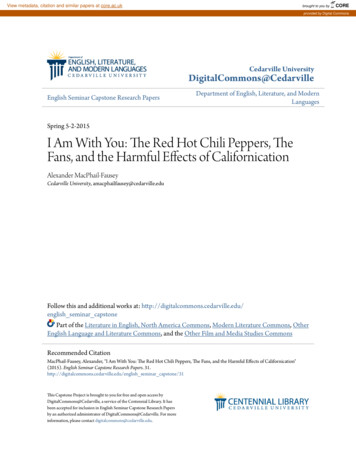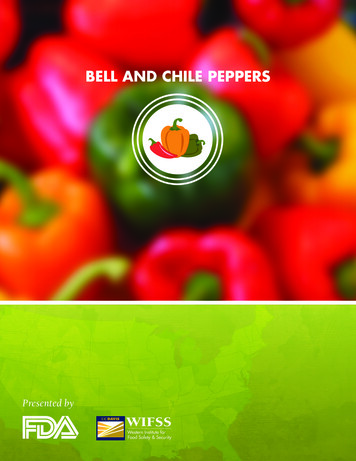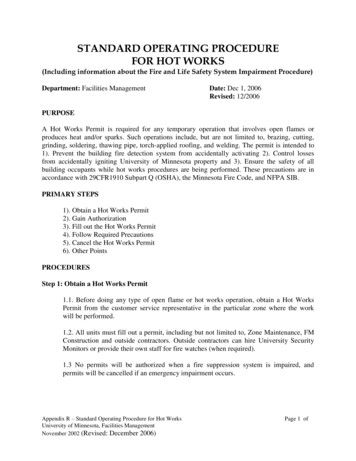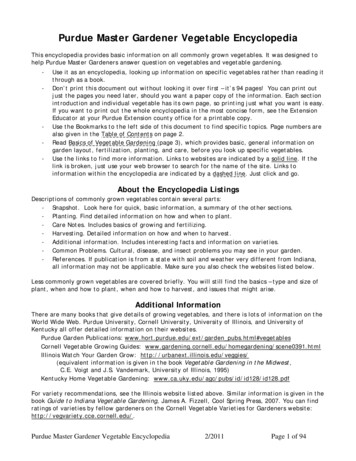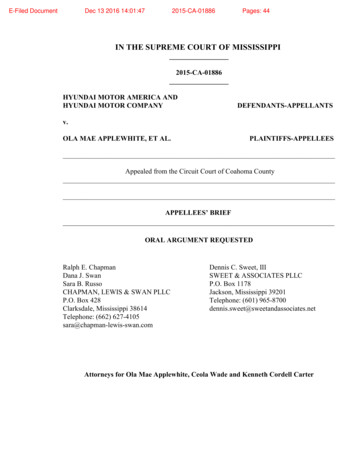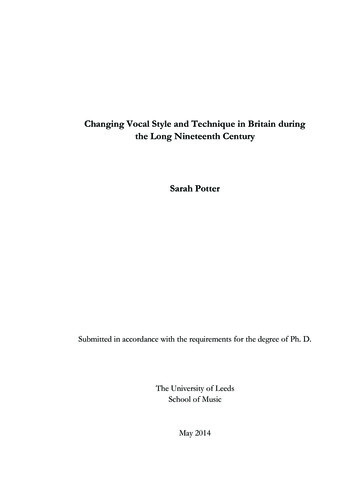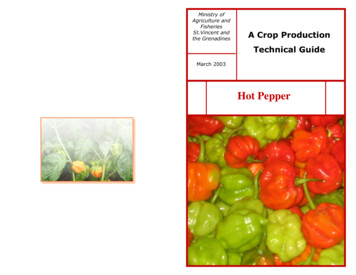
Transcription
SWEET & HOT PEPPERSPRODUCTION GUIDELINEC U S TO M E R S E R V I C E S : 0 8 6 0 7 8 2 7 5 3 W W W. S TA R K E AY R E S . C O. Z A M E M B E R O F T H E P L E N N E G Y G R O U PSEEDS OF SUCCESS
SWEET & HOT PEPPERS1. HISTORY AND BACKGROUNDSweet peppers, also called bell peppers and even some chilli peppers all belong to the speciesCapsicum annuum. Cultivars of these plants produce fruits in many different colours and shapes.Usually the colours range from red to yellow and orange, but more exotic colours include purple, whiteand lime green. The fruit is also frequently consumed in its unripe form, when the fruit is still green.Peppers are native to Mexico, Central America and northern South America. Pepper seeds were latercarried to Spain in 1493 and from there spread to other European, African and Asian countries.Today, Mexico remains one of the major pepper producers in the worldThe misleading name "pepper" (pimiento in Spanish) was given by Christopher Columbus uponbringing the plant back to Europe. At that time peppercorns, the fruit of Pipernigrum, an unrelatedplant originating from India, was a highly prized condiment. The name "pepper" was at that timeapplied in Europe to all known spices with a hot and pungent taste and so naturally extended to thenewly discovered Capsicum family. The most commonly used alternative name of the plant family,"chili", is of Central American origin. Even more so, is the variation of the phonetic “chil” sound derivedfrom the ancient Aztec language. Today, the word “chili” is used to describe a particular dish of foodcontaining beans and meat, whereas “chile” is used to describe the plant and fruit, usually pungent.Bell peppers are botanically fruits, but are generally considered in culinary contexts to be vegetables.While the bell pepper is a member of the Capsicum family, it is the only Capsicum that does notproduce capsaicin, a lipophilic chemical that can cause a strong burning sensation when it comes incontact with mucous membranes. The lack of capsaicin in bell peppers is due to a recessive form of agene that eliminates the production of capsaicin and, consequently also, the "hot" taste usuallyassociated with the rest of the Capsicum family. The term "bell pepper" or "pepper" or "capsicum" isoften used for any of the large bell shaped capsicum fruits, regardless of their colour.2. ADAPTABILITY2.1 CLIMATIC REQUIREMENTSClimate is one of the most important factors when determining planting times. Production of a peppercrop depends on the length of a growing season with optimal temperatures. The plant itself stopsgrowing at temperatures below 10 - 12 C, and at 6 C, the leaves can die and flower abortion willstart. The same will happen when temperatures increase to over 35 C. A pepper crop requires verystable temperature ranges with minimums and maximums not being too far apart. Temperaturevariation might result in poor fruit quality or reduced yields. Optimum temperatures would be:Day time:25 - 28 CNight time:16 - 18 CThis would also be the ideal temperatures for growing under protection. Long periods of overcastweather can also result in poor fruit set and loss of a crop. Hot peppers can withstand highertemperatures than sweet peppers.Table 1: Required temperature ranges per development stage for optimum sweet and hotpepper production.Temperatures ( C)Developmental StageGerminationMinimumOptimumMaximum2326 - 2830C U S TO M E R S E R V I C E S : 0 8 6 0 7 8 2 7 5 3 W W W. S TA R K E AY R E S . C O. Z A M E M B E R O F T H E P L E N N E G Y G R O U PSEEDS OF SUCCESS
Vegetative Growth2123 - 2528Fruit set – night1517 - 1820- day2023 - 2528Colouring1820 - 2430Cold Damageunder 6Frost Damageunder 1Terminal Damage-2For the development of the pepper plant, a relative humidity between 65 – 85% is considered optimal.High relative humidity levels negatively influence pollen release and distribution on the stigma. Highhumidity creates a favourable environment for the development of several foliar diseases.Conversely, low relative humidity may cause infertility, due to pollen drying out before germination ofthe pollen on the stigma, which leads to small, deformed or flat fruit. At relatively low humidity andhigh temperature, evaporation rate from the leaves is rapid. If the root system is unable to supply thewater volume required, it may lead to partial wilting of the growth tip and increase the incidence ofblossom end rot.2.2 SOIL REQUIREMENTSA very high level of soil fertility is required for the profitable production of a successful pepper crop.The quality and quantity of pepper fruits are of crucial importance and are greatly influenced by thefertility and nutrient levels of the soil. Pepper plants do not perform too well in very high clay soils.They rather prefer sandy to loam soils; In fact they will grow moderately well over a wide range of soiltypes, provided they are well drained to a depth of at least 600 mm. However certain criteria have tobe satisfied in terms of the soil structure and content to make it commercially viable. These factorsinclude:Nutrient compositionCompactionEffective soil depthpHCrop rotationHerbicide residuesWater holding capacityAll these factors can have major influences on the resulting yield. The soil must permit adequate rootgrowth to support the plant and supply water, oxygen and mineral nutrients and must be free of toxicelements. The rate of root growth is dependent on the degree of compaction or bulk density of thesoil. The degree of soil compaction varies with soil type and location. The rate of aerial and rootgrowth of plants increases with the oxygen contents of the soil. Root density is highest where there isa high rate of diffusion. Root development of pepper plants can be extensive if soil water and plantconditions are optimal. Early root development should be encouraged, because nearly all root growthoccurs before fruit set. The importance of organic matter cannot be over emphasized. Organic matterin the form of decayed leaves, compost, sawdust or animal manure is a source of plant nutrients andacts as a soil conditioner. It increases the capacity of the soil to retain water and nutrients. It alsopromotes root growth and the infiltration of water and air into the soil. Care should be taken to use,where applicable good quality organic matter known to be free of plant pathogens.2.3 PRODUCT TYPESCapsicums consist of approximately 20–27 species, five of which are domesticated: Cannuum,Cbaccatum, Cchinense, Cfrutescens, and Cpubescens. Many varieties of the same species can beused in many different ways; for example, Cannuum includes the "bell pepper" variety, which is sold inboth its immature green state and its mature red, yellow or orange state. Many types of peppers areC U S TO M E R S E R V I C E S : 0 8 6 0 7 8 2 7 5 3 W W W. S TA R K E AY R E S . C O. Z A M E M B E R O F T H E P L E N N E G Y G R O U PSEEDS OF SUCCESS
used in dishes across the world. The "hotness”(pungency or spicyheat) of peppers can be measuredaccording to Scoville Heat Units (SHU). The mildest peppers such as sweet bell peppers and cherrypeppers are at the bottom of the Scovillescale. Peppers with average pungency like serrano and redcayanne peppers have moderate Scoville Heat Units. At the top of the scale is the habanero type aswell as Bhut Jolokia, considered to be the hottest chilli in the world.3. CULTIVATION PRACTICES3.1 SOIL PREPARATIONSoil preparation improves the potential for profitable production of peppers. Any primary soilpreparation must be aimed at creating growing conditions for pepper plants to develop the optimalroot system in a specific soil profile. The highest percentage roots will be found in the top 600mm ofthe soil. The advantages of soil preparation are:No restrictions on root development.Less chance of compaction.More oxygen in the soil creating better root development.Higher yield.Reduction in production costs.More vegetative growth.More tolerance to drought and stress.Less root disease prevalence.Horizontal and vertical compaction layers broken.Better water retention.Increased uptake of moisture and nutrients.The choice of preparation systems should be determined by the plant requirements and the soil type.Thereafter, economic factors should be considered. No standard system can be recommended on allsoil types. The choice of preparation method should be made based on the clay content of the soil.For example on sandy soils the focus should be to reduce compaction and erosion, where on heaviersoils it will be to reduce crust formation. Soil preparation should be done to depths varying between300 – 600mm. Ridging is highly recommended, and should be done according to the land contours.The main advantage of ridging a pepper crop is to keep excess water away from the plant, improvedoxygenation of the root zone, increased soil depth in the growing bed, to promote root developmentand keep root diseases at bay.3.2 PLANTING PERIODSThe earliest period for seedling establishment would be when the soil and air temperatures at leastmeet the minimum requirements for plant growth.The latest seedling establishment period would be after allowance has been made for the growthand harvest periods to be completed before adverse conditions sets in.Due to the effect of certain factors being prevalent at specific locations, within each of these areas theplanting times may be earlier or later than the times given below.Establishment periods for the main production areas of South Africa will then be:1. Lowveld (frost free areas) – Feb to May2. Middleveld (moderate areas) – Sept to Dec3. Highveld (cold areas) – Oct to Nov4. Western Cape – Oct to DecUnder ProtectionGrowing peppers under protection provides possibly the ultimate level of control currently available toproducers. Protection against the natural elements and pests is obtained by the use of a transparentC U S TO M E R S E R V I C E S : 0 8 6 0 7 8 2 7 5 3 W W W. S TA R K E AY R E S . C O. Z A M E M B E R O F T H E P L E N N E G Y G R O U PSEEDS OF SUCCESS
A pepper plant starts to develop with a period of leaf growth. It then sets the first flower in the axis ofthe first two branches. Each branch forms one leaf, one flower and two new branches. From here theplant develops very quickly and flowering habit increases dramatically.Once the fruit has set, it is retained by the plant for further growth development. Pollination is followedby fruit set. The pollen must be moved from the male to the female part of the flower. This occurs byway of the wind or visits by insects such as bees. Pollination in the open land is usually much betterthan with greenhouse production due to the natural wind factor.Temperatures for good fruit set should be between 20 and 30 Celsius. In drought and heat stress,pepper plants not only lose flowers, but also buds. Loss of buds delays flowering by several weeksand reduces yields dramatically. Factors influencing flower drop or loss of buds include poor lightintensity, excessive nitrogen and insect damage. A pepper plant develops hormones to control buddrop. Normally buds produce auxin, which allows it to develop and grow. However, under severestress conditions, pepper plants generate ethylene, which causes the plants to drop their buds withintwo days.If a pepper plant in production, bearing fruit and buds and setting flowers, is under severe stress, itwill first drop its flowers and small buds. In an attempt to survive, the plant will retain the large fruit tofinish its life cycle by at least producing some seed for future offspring. Pepper varieties setting fruitunder very cold conditions tend to have flat or misshaped fruit with no seed set. This fruit is notmarketable and needs to be removed in order to conserve energy for the plant.Farmers can ensure good fruit set on their plants by taking the following actions:Select varieties with good fruit set under local conditionsEnsure good irrigation managementEnsure good fertilisation managementUse a good preventative spraying programme against insect infestationAdapt the fertiliser programme to varieties that have the tendency to flushUse varieties with extended flower set so as to spread the risksResearch in greenhouse production has shown that there is a vital difference between tomato andpepper fruiting and growth relationships. Tomatoes show a negative correlation between vegetativegrowth and fruiting, therefore requiring strict control during the first phases of development. Peppers,however, require strong initial growth to promote earliness and abundant fruit set, showing a positivecorrelation between these stages. Although most pepper field crops are treated as annuals,technically they can be grown as perennials in a protected growing environment but careful economicconsiderations should be given to the feasibility of such a decision.Factors influencing pollination:High temperatures – pollen not alive.Low temperatures, high humidity – pollen grains stick together (misshaped or flat fruit).Insufficient humidity – stigma to dry, pollen does not germinate.High humidity, low light – pollen makes clumps, cannot germinate on the stigma.High temperatures, low light – style elongates, pollen cannot reach ovules.4.4 WEED CONTROLIn pepper production certain factors may influence yields negatively. These factors could includeinsect infestations, and fungal or bacterial infections. Weeds also contribute as a yield restrictingfactor. Firstly, weeds compete directly with the crop for moisture and nutrients available in the soil.Weeds could also be a host for various pests and diseases. It is also known that some weeds havethe ability to produce enzymes that reduce plant growth in some crops. Capsicums are very sensitiveto weed competition, particularly12 to 48 days after transplant. Problems occurring during this stagecould severely affect the yield. Therefore it is crucially important to control weeds at this stage. Thebest and most effective way to control weeds would be:C U S TO M E R S E R V I C E S : 0 8 6 0 7 8 2 7 5 3 W W W. S TA R K E AY R E S . C O. Z A M E M B E R O F T H E P L E N N E G Y G R O U PSEEDS OF SUCCESS
material that allows sunlight to enter the structure and then converting the trapped solar energy toheat, thus providing increased temperatures for continued production. In advanced structures,humidity and even light can be controlled to ensure maximum crop yields.3.3 SEEDLING PRODUCTIONSeedling establishment:Model 128, 200 seedling trays are the most popular.Although more expensive, larger seedling trays lead to better and more root development.Seedlings take 6 weeks in summer to reach transplant maturity.Seedlings take about 8-10 weeks in winter to transplant maturity.Deep sowing: More advantageous in warmer conditions.Seed takes longer to surface due to cooler temperatures and longer growing distances.Shallow sowing: More advantageous in cooler conditions.Seed surface quicker due to warmer temperatures and short growing distances. Sufficient levelsof moisture are necessary.The effect of soil- or growth media temperature on seed germinationTable 2 gives a good indication of the best temperature ranges for seed germination. At the optimumsoil or growth media temperatures of 25 to 30 C it will take pepper seeds 8 days to germinate. Attemperatures ranges of 0-5 C, 40 C and above no germination is expected with seed being dormant.Table 2: The effect of soil temperature on pepper seedling emergence.Soil Temperatures ( C)0510152025303540Germination (days)00025138890Seedlings should be grown in a well-aerated medium, which has good water holding capacity and at apH of around 6.5. Generally, peat, bark and vermiculite mixes are used. Media problems typicallyinclude excessive tannins and low air filled porosity, which results in poor drainage and the buildup ofgreen mould. The medium should be pre-enriched and the seedlings should be fertilized.Seedling management is a critical factor, and the following points may result in physiologicaldisorders:Incorrect sowing time.Cold temperatures, particularly below 7 C.Cold grown seedlings.Over-fertilization of seedlings.Oversized seedlings at transplant.Temperature differences between the seedling nursery and the farm.A precision seeder is recommended to place single seedlings at a uniform depth.3.4 PLANT POPULATION AND SPACINGOpen fieldThe single most important factor when making a decision around plant population is the type ofchemical spraying system- or method that the grower is going to use for the duration of the crop.Everything should be designed around this implement so as to get in between rows when spraying toeffectively control pests and diseases. Plant population is around 30 000 plants per Ha. This is doneby normal single line rows, e.g. 1.5 meters in between rows by 200mm between plant spacing as pertable 3 underneath.A tramline system is also very popular. This is done where the rows are planted closer together or ona dripper system on each side of the dripper line. The advantage of this system is the achievement ofa dense plant canopy that protects the fruit against sunburn. The negative aspect of this is thatchemical control might be a challenge.C U S TO M E R S E R V I C E S : 0 8 6 0 7 8 2 7 5 3 W W W. S TA R K E AY R E S . C O. Z A M E M B E R O F T H E P L E N N E G Y G R O U PSEEDS OF SUCCESS
For ‘tramline’ sy stem:60 cm between tramlines.100 cm between rows.40 cm between plants.60 cm between tramlines.100 cm between rows.30 cm between rows.} 30 000 plants per/ha} 35 000 plants per/haTable 3: Plant population guideBetween Rows (cm)150175200225250Between plants (cm)3035202533 00028 50025 00022 00026 40022 80020 00017 60022 00019 00016 70014 60020 00016 00013 300405019 00016 30014 30012 70016 50014 28512 40011 00013 20011 40010 0008 80011 40010 0008 000The plant population table above can be used as a quick guideline. For example: if the distancebetween rows is 2 meters with the distance between plants 30 cm, one will have a plant population of16700 plants per ha.Production under protectionThe planting density should be around 3-4 plants/m². This is mainly done where medium to smallerfruit is needed for speciality and high quality markets. Plants are trained to single, double or threestems on supporting strings and stopped at a height of2 meters or more.3.4.1 TRANSPLANTING SEEDLINGSThe production of good quality, healthy seedlings require the correct choice of both variety andseedling grower.The correct soil preparation, analysis and fertilizer application prior to planting alsoneeds to be done. Before seedlings are collected from the nursery, land preparation should becompleted and irrigation systems should be in place. At this point some growers already install thetrellising system such as poles and first wires. Seedlings must be hardened off before leaving thenursery. This is done by making sure that excessive nitrogen and irrigation is kept to a minimum. Twoto five days before collecting the seedlings, the trays must be taken out of the nursery and placed in aposition where more sunlight is available to the plants.It is highly recommended to always establish seedlings in wet soil. Always make sure that the holeson the ridges where seedlings are about to be transplanted are exactly the same size as the seedlingplugs. This will prevent issues such as J-rooting where seedling plugs are forced into the soil androots are bent over resulting in seedling uniformity issues and yield losses. Although it is notrecommended to establish these plants, it happens from time to time that a grower receives overmature or taller plants than is considered ideal. In this instance it is recommended to sterilize the stemwith a fungicide and plant the seedling deeper into the soil than normal. This is not the best thing todo, but lateral roots will shoot from the stem to help the plants. Sometimes seedlings are receivedwith flowers or buds already setting, it is recommended to remove them at planting in order to give theplant more energy to establish itself. Controlling field irrigation with the use of soil moistureinstruments such as irrometers or tensiometers is highly recommended to ensure the development ofa healthy root system and avoiding over-irrigation. Domesticated peppers, in particular sweepC U S TO M E R S E R V I C E S : 0 8 6 0 7 8 2 7 5 3 W W W. S TA R K E AY R E S . C O. Z A M E M B E R O F T H E P L E N N E G Y G R O U PSEEDS OF SUCCESS
peppers are very prone to root rot diseases such as Phytophtoracapsici and saturated soil conditionsfor long periods of time should be avoided at all costs.3.5 FERTILIZATIONDuring the production of sweet and hot peppers, correct fertilization is the single most important factorthat determines the success of a crop. With good management practices these crops could beproduced under a wide range of different conditions, however some growing conditions are morefavourable than others. In order to calculate the correct nutrient requirement, the following aspectsneed to be available and taken into consideration:Nutrient withdrawal figuresFertilizer used in the past on the specific area intended to be planted.Soil type.Soil analyses.Soil Acidity (pH).Quality of irrigation water.Micro elements.3.5.1 FERTILIZATION GUIDELINEThe ideal soil analyses or soil status for sweet and hot pepper production should be:pH (H2O): 5.6 – 6.8 (NB!! MUST BE CORRECT.)P: 30 – 60 mg/Kg (Bray1)K: 100 – 250 mg/KgCa: 300 – 2000 mg/KgMg: 120 – 300 mg/KgNa: 10 – 50 mg/KgTable 4:Nutritional requirements of pepper in open fieldExpected yield(Ton/ha)Removal by yield (kg/ha)Uptake by whole plant 2142825347115Table 5:Nutritional requirements of pepper in greenhouseExpected yield(Ton/ha)Removal by yield (kg/ha)NPKCaUptake by whole plant 97150300905257545547145841336114C U S TO M E R S E R V I C E S : 0 8 6 0 7 8 2 7 5 3 W W W. S TA R K E AY R E S . C O. Z A M E M B E R O F T H E P L E N N E G Y G R O U PSEEDS OF SUCCESS
018910964271463.6 IRRIGATIONThe supply of adequate water to the roots of a pepper plant is critical. Under- or over irrigation canhave a devastating effect on the outcome of the crop. It is therefore very important to apply water atoptimal times. More frequent light irrigations are needed on sandy soils. Higher applications withlonger intervals will be needed on clay soils.Too little water might lead to:Sub-optimum yields.Decrease in the photosynthetic rate.Plants developing stunted growth.No production of flowers.Low percentage fruit set.Slow fruit development.Small fruit sizes.Poor quality.Flower abortion.Too much water might lead to:Not enough oxygen in the soil.Plants becoming wilted.Root diseases becoming prevalent.Stunted plant development.When scheduling irrigation, the size of the root system at the time of irrigation needs to be taken intoaccount. In general, the root system can be compared to the aerial growth of the plant. The rootsspread into the soil at a similar rate to which the aerial growth develops. Most pepper roots occur inthe top 500 – 600 mm of soil level, even at maturity. For this reason irrigation should be monitored atthis level with irrometers. Deep, thorough irrigations are preferable to light and regular wateringintervals. Drip or flood irrigation is preferable to overhead irrigation, due to susceptibility to foliardiseases. The amounts of water used will vary depending on the climatic conditions. During the coolermonths peppers require about 25mm per week and this might increase to 50mm under very hot,windy and dry conditions. For irrigation purposes, the growth of peppers can be divided into fourgrowth stages.Stage 1: EstablishmentCan last up to 2 weeks.Seedling establishment takes place and plants start to grow actively.Low amounts of water are used.After seedling establishment to just before first flower, it is highly recommended (although afine line of management) to reduce water drastically. It will force the roots to growaggressively deeper into the soil looking for moist. This will help the plants at fruit set stage tohandle difficult and stress related periods better due to the increased roots.Stage 2: Vegetative growthDevelopment of first flowers and fruit.Double the amount of water is used compared to the previous stage.Stage 3: Fruit setGrowth is at its highest.Water usage at this stage is at its highest during the lifespan of the crop.Stage 4: Ripening and harvestingC U S TO M E R S E R V I C E S : 0 8 6 0 7 8 2 7 5 3 W W W. S TA R K E AY R E S . C O. Z A M E M B E R O F T H E P L E N N E G Y G R O U PSEEDS OF SUCCESS
Very high loads carried on the plant.Water usage starts to decrease.Table 11 IRRIGATION mm)%0-2400203-67 - 1516 - AMOUNTNEEDED(mm)10 - 150.40.60.83-55-77 - 1015 - 2530 - 4020 - 30Please Note! Soil should be wet at planting. Irrigate 20 - 30 mm directly afterplanting.4. OTHER CULTURAL PRACTICES4.1 TRELLISINGThis is one of the expensive factors contributing to pepper production costs. Costs will directly belinked to the chosen variety. Some compact types don’t need to be trellised, but are more prone to aconcentrated sets over a shorter period of time. More compact types will use less inputs comparedthe taller growing indeterminate types. Indeterminate or less compact types needs to be trellised andare known to grow and develop over longer period of time. It has an extended set and harvest periodresulting in higher yields. The advantages and disadvantages of trellising and non-trellising of pepperswould be:Trellising:Advantages:Very high percentage pack outs.Highest percentage first grade pack out.Less disease prevalence.Less spraying needs to be done.Reduced risks.Disadvantages:Increased productions costs.Non-Trellising:Advantages:Lower input costs.Disadvantages:Reduced fruit quality and lower pack out percentage.Higher percentage plants falling over.Higher percentage fruit rot.Higher percentage leaf diseases prevalent.Increased spraying program.For open field trellising poles should be between 1.2 – 1.5 meters long. Treated poles last longer, butcaution should be taken with Creosote treated poles as this might burn some of the plants on hotdays. Poles should be planted directly after seedling transplantation. Some growers even do theplanting of poles before the time. Wire or rope can be used and should be done at first flowering stageC U S TO M E R S E R V I C E S : 0 8 6 0 7 8 2 7 5 3 W W W. S TA R K E AY R E S . C O. Z A M E M B E R O F T H E P L E N N E G Y G R O U PSEEDS OF SUCCESS
or around one month after transplant. Although more expensive, wires last longer and don’t have theability to gather diseases. Rope could be infected with bacterial spores and should be sterilized afteruse. Poles should be planted around 40 – 50 cm into the soil and not more than 3 meters apart. It isessential that the end or corner poles are supported. Poles should be able to carry the plant and itsfruit, and withstand side winds. When rows are 1.5 meters apart and the crop is planted in a 1 hectaresquare block of single lines, one would need 2200 poles and around 40 000 meters of wires if 3 setsor 6 lines of wire are used.For the ‘tramline’ system (as discussed in the plant population section) one would need double theamount of poles as it would be placed opposite each other on either side of the tramlines.A pepper plant has the ability to grow and develop very fast and constant trellising should be done.The plant will make side shoots that grow to the sides of the main plant. These shoots should beneatly tucked in between the wires and not damaged. This should at least be done on a weekly basis.Trellising under protection could be done in two ways.One way would be to do it the same way as the conventional open field method, or what growers referto as the Spanish method. With this method plants grown in a single line or double lines (tramline) areboxed on either side with poles, string or wire. Plants will then grow inside this boxed area upwards tothe desired height. Layering of plants grown this way would not be possible and one will need to usethe height to the top of the structure to its maximum potential.The alternative way would be done by trellising a steel wire at 2 – 2.5 meters above the single ordouble row. Rope or twine is then hung down from this wire for the plant or stems to be able to beguided up against the rope. As the plant matures, the rope would then be shortened or rolled up at thetop if necessary, or the plant would guide itself along the rope to the top. With this method, only oneor two stems are allowed to grow, and all suckers are removed. Layering of plants could be done withthis method as all the plants and or stems have their own individual supportive string.4.2 PRUNINGPepper plants grown in a greenhouse are normally trained to two stems and need good support froman overhead trellising system due to the brittleness of their stems. The first training of the stems isdone one month after transplanting and will continue every other week, depending of the growth rate.This type of training system allows for better light penetration, but if more light is available, morestems per plant may be considered. A maximum of up to four stems are used. One fruit should set forevery two leaves the plant produces and flowers are allowed to set after the lateral branches haveproduced four leaf axils after the fork. The first flower produced by th
Sweet peppers, also called bell peppers and even some chilli peppers all belong to the species Capsicum annuum. Cultivars of these plants produce fruits in many different colours and shapes. Usually the colours range from red to yellow and orange, but
